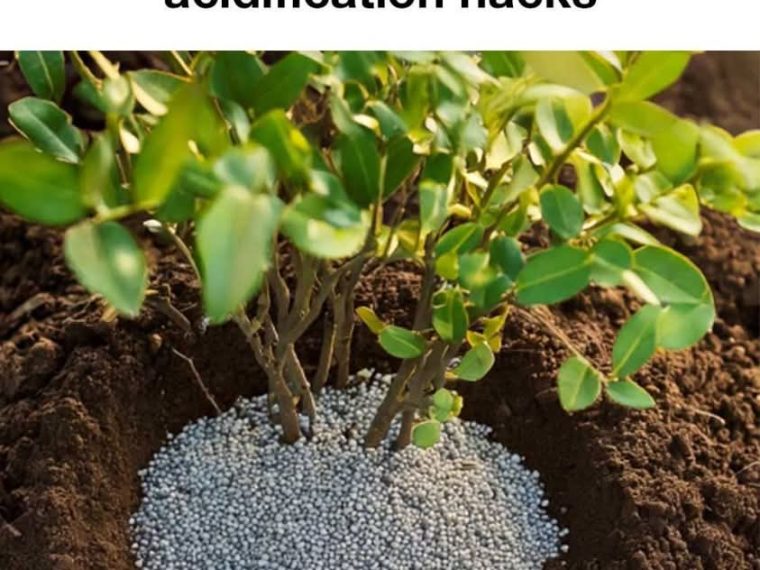Blueberries are one of the most rewarding fruits to grow at home, offering delicious and nutrient-packed berries for years to come. However, many gardeners struggle to grow thriving blueberry bushes because these plants have very specific soil requirements—especially when it comes to acidity.
If you’ve ever had trouble getting your blueberry bushes to thrive, or you’re looking for fast and effective soil acidification hacks, you’re in the right place. This guide will take you step by step through everything you need to know about growing healthy, productive blueberry bushes and making sure your soil is just right for them.
1. Why Growing Blueberries Can Be Challenging
Many people assume blueberries are easy to grow, only to be disappointed when their plants struggle. The biggest mistake? Ignoring soil pH.
Blueberries need acidic soil with a pH between 4.0 and 5.5. If your soil is too alkaline, the plants won’t absorb nutrients properly, leading to stunted growth, yellowing leaves, and poor fruit production.
Common Blueberry Growing Problems
- Slow Growth: If your blueberry plant isn’t growing well, it could be because the pH is too high, preventing nutrient absorption.
- Yellow Leaves (Chlorosis): If your blueberry leaves turn yellow, your soil is likely too alkaline, causing an iron deficiency.
- Small or No Fruit: Without proper nutrients, your plant may produce small, tasteless berries or none at all.
Now that we understand the importance of soil acidity, let’s talk about fast and effective soil acidification hacks to give your blueberries the best possible environment to thrive.
2. Fast Hacks for Acidifying Soil for Blueberries
If your soil isn’t acidic enough, don’t worry—there are several quick and effective ways to lower pH levels and create the perfect growing conditions for blueberries.
1. Use Sulfur for Long-Term Soil Acidification
Sulfur is one of the most effective ways to lower soil pH. It reacts with soil bacteria to create sulfuric acid, gradually making the soil more acidic over time.
- How to Use:
- Apply granular elemental sulfur at a rate of 1–2 pounds per 100 square feet.
- It takes a few months to fully acidify the soil, so apply it in the fall or early spring.
- Pro Tip: If you need faster results, use aluminum sulfate, which reacts instantly with water to lower pH. However, use it in moderation to avoid damaging the plants.
2. Acidify Soil with Vinegar for Quick pH Drops
Vinegar is an instant soil acidifier and can be useful for short-term adjustments.
- How to Use:
- Mix one cup of white vinegar into one gallon of water and apply it to the soil around your blueberry plants.
- This is a temporary fix and should be repeated every two weeks for continued acidity.
- Pro Tip: Don’t overuse vinegar—it can kill beneficial microbes in the soil if used too frequently.
3. Coffee Grounds: A Natural and Slow-Release Acidifier
Used coffee grounds are slightly acidic and add organic matter to the soil while helping lower pH levels gradually.
- How to Use:
- Mix used coffee grounds into the topsoil around blueberry bushes.
- You can also brew coffee ground tea by soaking them in water and using it as a soil drench.
- Pro Tip: Too many coffee grounds can clump together, preventing water drainage. Mix them with compost or mulch for best results.
4. Pine Needles & Peat Moss: Natural Acidic Mulch
Pine needles and peat moss are naturally acidic and help maintain the ideal pH level for blueberries.
3. Give Your Blueberries Time to Mature
Blueberry bushes take 2–3 years to produce a good harvest and reach full productivity by year 5–6. Be patient!
Final Thoughts: Blueberry Success Starts with the Right Soil
Growing thriving blueberry bushes isn’t hard when you provide the right conditions—especially acidic soil. By following the fast soil acidification hacks and proper care techniques outlined in this guide, you’ll set yourself up for an abundant blueberry harvest year after year.
So, whether you’re a beginner or an experienced gardener, start implementing these tips today and enjoy fresh, delicious blueberries straight from your garden! 🫐💙




